If you’re looking to impress your guests with a delicious and elegant dish, the halibut Olympia recipe is the perfect choice. This rich and flavorful recipe combines tender halibut with a unique blend of ingredients that elevate the dish to gourmet levels. Whether you’re preparing it for a special occasion or just a memorable dinner, this recipe brings out the delicate flavors of halibut, paired with the fresh, savory elements of a classic Olympia twist.
The halibut Olympia recipe is a delightful mix of fresh halibut fillets, seasoned to perfection and topped with a buttery, creamy sauce that features garlic, lemon, and herbs. The addition of Olympia-style ingredientsn such as artichokes, capers, and a hint of white wine, gives the dish an unforgettable taste that balances the richness of the fish. This recipe is a fantastic way to showcase the versatility of halibut while incorporating flavors that are both bold and comforting.
Perfect for those who appreciate seafood with a refined touch, the halibut Olympia recipe offers a restaurant-quality meal that’s surprisingly easy to prepare. With a few key ingredients and a bit of preparation, you can serve up a dish that will leave everyone asking for seconds. Whether you’re a seasoned cook or a beginner in the kitchen, this recipe provides an elegant way to enjoy halibut like never before.
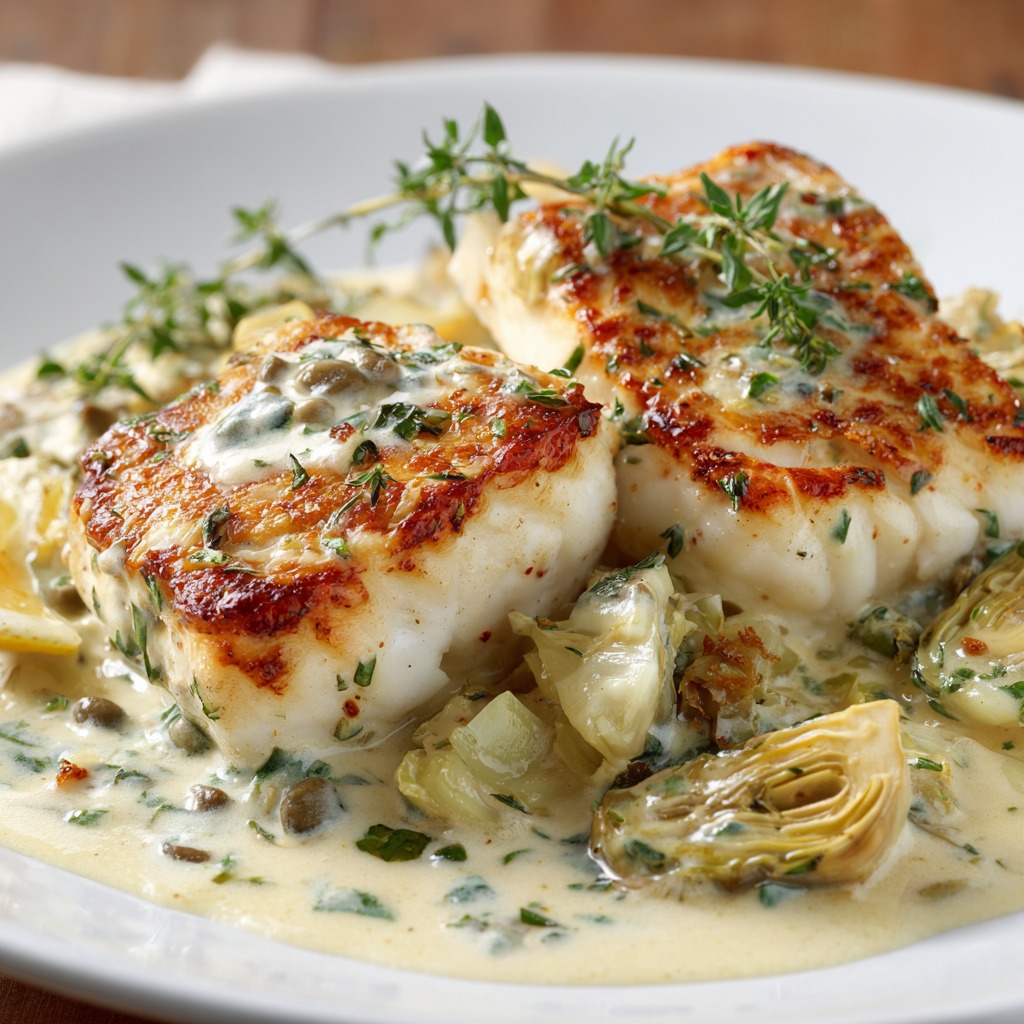
- Origins of Halibut Olympia Recipe
- Why Halibut Olympia Recipe is Perfect for You
- How to Prepare Halibut Olympia Recipe
- Best Side Dishes for Creamy Halibut Olympia
- Pro Tips for Cooking halibut alyeska recipe
- Storing and Reheating Halibut Olympia Recipe
- Tips & Tricks for Perfect
- Variations of Halibut Olympia Recipe
- Health Benefits of Halibut Olympia Recipe
- Halibut Olympia Recipe From DishBloom!
- Share Your Twist!
Origins of Halibut Olympia Recipe
The Halibut Olympia has its roots in the Pacific Northwest, where halibut is a popular and abundant fish. This dish is an innovative take on traditional seafood recipes, particularly influenced by the region’s rich culinary history. The concept of “Olympia” in the recipe draws inspiration from the flavors and ingredients typical of the Pacific Northwest, such as artichokes, capers, and the use of butter and fresh herbs. These ingredients were often paired with fresh fish caught in the region’s waters, creating a distinct, elevated dish that highlights the delicate taste of halibut.
The exact origins of the Halibut Olympia are difficult to pinpoint, but it is thought to have evolved from the region’s love for fresh, local seafood and its penchant for rich, savory sauces. The name “Olympia” likely refers to the nearby Olympia, Washington, a coastal city known for its access to fresh seafood and its influence on regional cooking. This dish may have originated in local restaurants or kitchens where chefs sought to highlight the bounty of the sea with a refined and flavorful twist.
Over time, the Halibut Olympia recipe gained popularity for its ability to take a simple fish like halibut and transform it into something extraordinary. The dish embodies the essence of Pacific Northwest cuisine, using fresh, local ingredients to create a memorable meal. Its inclusion of both traditional and modern flavors makes it a beloved choice among seafood enthusiasts and home cooks alike.
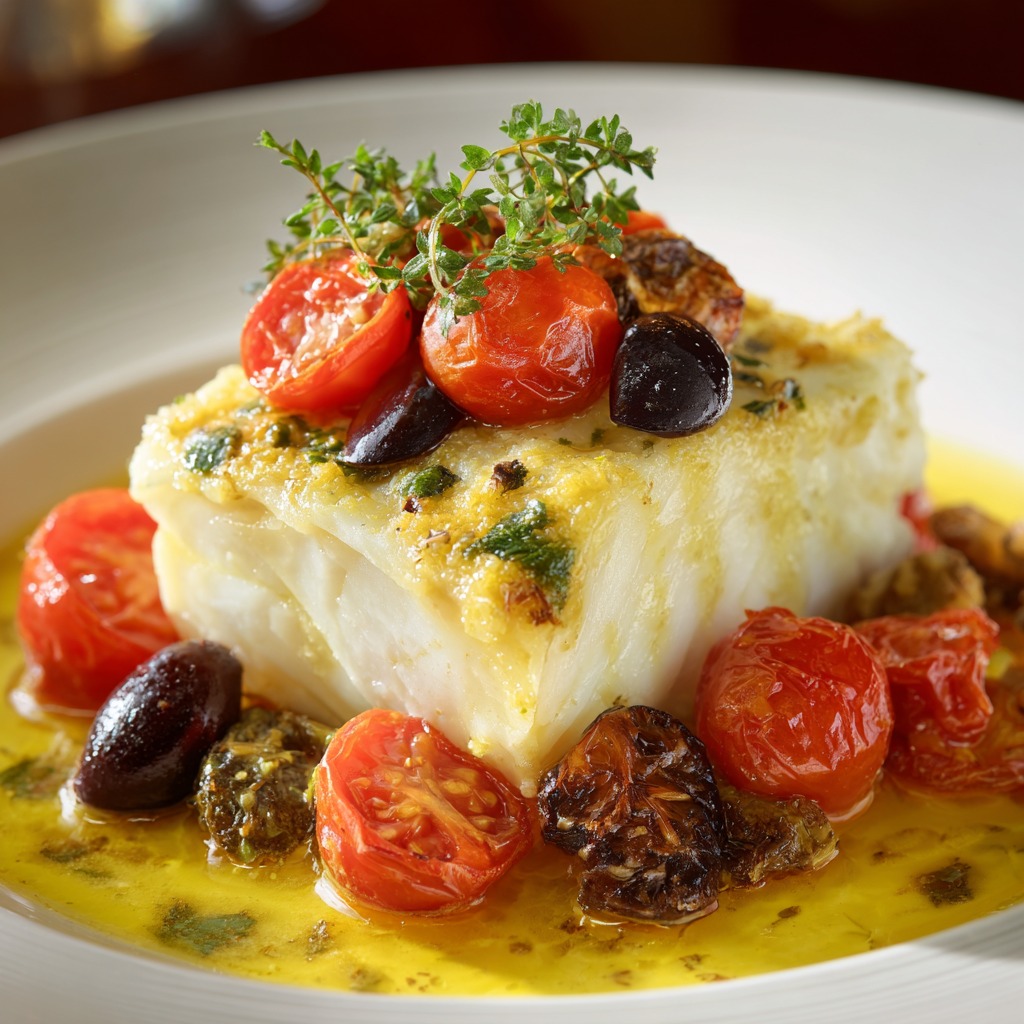
Why Halibut Olympia Recipe is Perfect for You
The Halibut Olympia recipe is perfect for you if you’re looking to indulge in a flavorful, sophisticated dish without the complexity of gourmet cooking. This recipe strikes the ideal balance between fresh, high-quality ingredients and an easy-to-follow preparation process. Whether you’re an experienced home chef or just starting, it offers a rewarding cooking experience that guarantees a mouthwatering result. The tender halibut, complemented by the rich buttery sauce and tangy elements like capers and artichokes, makes for a meal that’s both impressive and comforting.
If you’re a fan of seafood but want to try something a little different, the Halibut Olympia is the perfect choice. It introduces a new way to enjoy halibut, elevating the fish with a mix of savory and fresh flavors that complement its delicate taste. The combination of citrusy lemon, garlicky butter, and herbs provides a refreshing yet indulgent twist to the fish, making it stand out from typical seafood dishes. Plus, the recipe can easily be adapted for different tastes, adding a personal touch while maintaining the core essence of the dish.
The Halibut Olympia is also ideal for those who want to impress guests or serve a special meal on a weeknight. It’s not only visually stunning but also nutritious, with halibut offering a great source of lean protein and healthy fats. The balance of flavors ensures that every bite is a delightful experience. Whether you’re hosting a dinner party or enjoying a quiet meal at home, this recipe provides a sophisticated and delicious option that is sure to be a hit every time.
Quick Facts About
- Main Ingredient: The recipe centers around halibut, a mild-flavored, flaky white fish that is rich in omega-3 fatty acids and high-quality protein.
- Flavor Profile: It combines rich, buttery flavors with tangy elements like lemon and capers, and the freshness of artichokes, creating a balanced and savory dish.
- Origin: While its exact origins are unclear, the recipe is influenced by Pacific Northwest cuisine, which is known for its emphasis on fresh, local seafood.
- Serving Occasion: Perfect for both casual weeknight meals and elegant dinner parties, it’s a versatile dish that can impress guests with minimal effort.
- Cooking Method: The halibut is typically pan-seared or baked, then topped with a creamy, flavorful sauce featuring garlic, butter, white wine, and herbs.
- Nutritional Value: Halibut is a healthy choice, being low in fat but rich in protein and essential nutrients like vitamin D and selenium.
- Pairing: Pairs well with light sides such as steamed vegetables, roasted potatoes, or a fresh salad to balance out the richness of the fish and sauce.
- Adaptability: The recipe can be easily customized by adding ingredients like spinach, mushrooms, or different herbs to suit personal preferences.
Let me know if you’d like any more details on any of these!
Key Benefits
Rich in Nutrients: Halibut provides high-quality protein, omega-3 fatty acids, vitamins (like D and B12), and minerals (such as selenium), making it a healthy choice for heart and brain health.
Easy to Prepare: Despite its elegant appeal, the recipe is simple to make, perfect for both beginners and seasoned cooks looking for a quick, flavorful dish.
Impressive Presentation: The dish is visually stunning, making it ideal for dinner parties or special occasions when you want to impress your guests.
Versatile Pairings: It pairs wonderfully with sides like roasted vegetables, mashed potatoes, or fresh salads, giving you the flexibility to customize the meal to your liking.
Low in Calories, High in Protein: The halibut is naturally low in fat and calories but rich in protein, making it a healthy and satisfying meal option without the excess calories.
How to Prepare Halibut Olympia Recipe
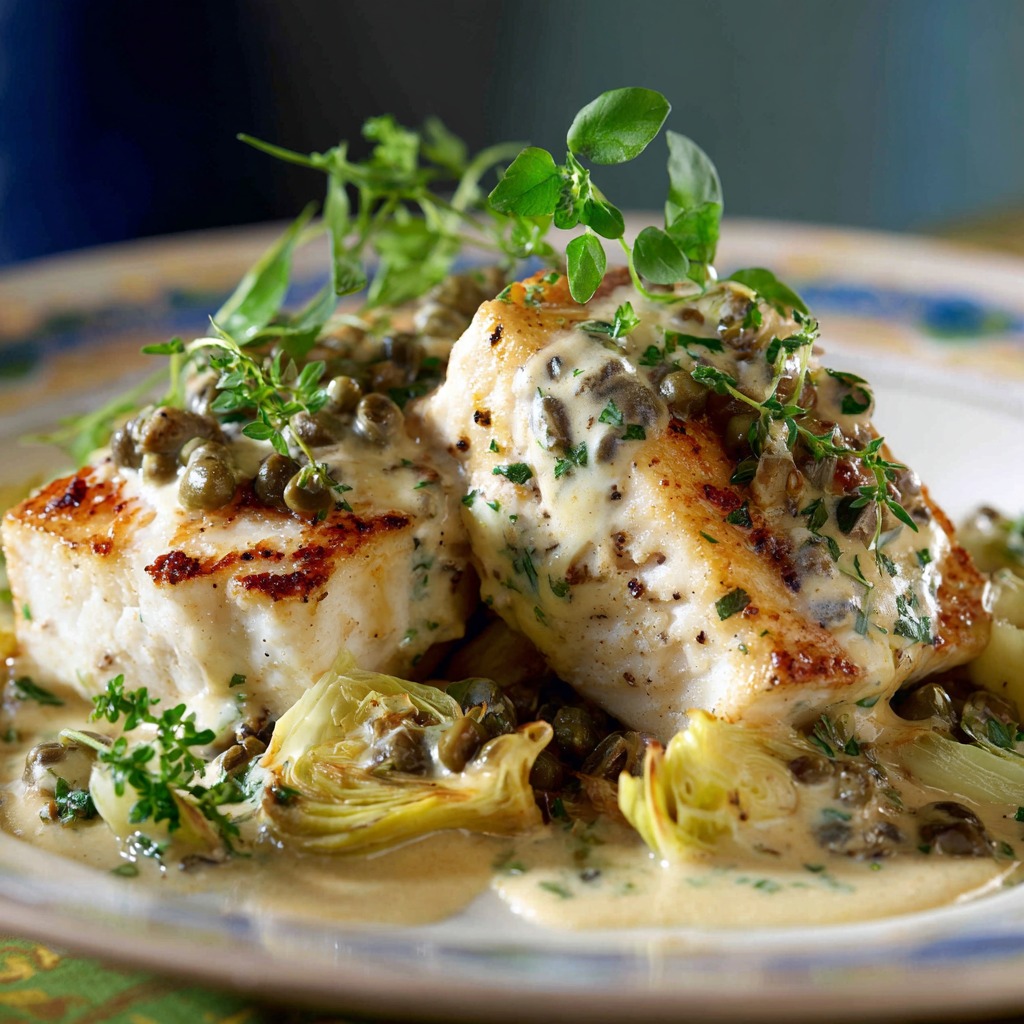
Quick Overview
The Halibut Olympia is a gourmet seafood dish that combines tender halibut with a rich, flavorful sauce. The dish is inspired by Pacific Northwest cuisine, incorporating ingredients like garlic, lemon, butter, and capers, with a hint of white wine and artichokes to enhance the fish’s natural flavors. It’s a simple yet sophisticated recipe that elevates halibut, turning it into an impressive meal suitable for both casual dinners and special occasions.
This recipe is not only delicious but also packed with nutrients, including high-quality protein and omega-3 fatty acids from the halibut, making it a healthy choice. The creamy, savory sauce pairs perfectly with the mild, flaky fish, while the added tang from the capers and lemon gives it a refreshing balance. Whether you’re a novice cook or an experienced chef, the Halibut Olympia recipe is a versatile and easy-to-prepare dish that’s sure to please seafood lovers.
With its elegant presentation and vibrant flavors, the Halibut Olympia is a perfect option for those looking to enjoy a light, nutritious, and satisfying meal that feels like a treat.
Essential Ingredients for
- Halibut Fillets: The star of the dish, providing a mild, flaky texture that absorbs the flavors of the sauce beautifully.
- Butter: Used to create a rich, creamy sauce that coats the fish and adds a velvety texture to the dish.
- Garlic: Adds depth of flavor and enhances the savory elements of the sauce.
- Lemon: The zest and juice of lemon provide a refreshing tang that balances the richness of the butter.
- Capers: These small, briny buds give the dish a burst of tangy flavor, which complements the buttery sauce.
- Artichokes: Fresh or marinated artichokes add a slight earthiness and texture, contributing to the complexity of the dish.
- White Wine: A splash of white wine enhances the sauce with acidity and depth, bringing all the flavors together.
- Fresh Herbs: Typically parsley or thyme, these herbs add a fresh, aromatic note to the dish.
These ingredients work together to create a well-balanced, flavorful dish that highlights the delicate taste of the halibut while offering a luxurious sauce.
Ingredient List with Proportions
Here’s an ingredient list for the Halibut Olympia with suggested proportions:
Ingredients:
- Halibut Fillets – 4 fillets (about 6 oz each)
- Butter – 4 tablespoons (divided)
- Garlic – 3 cloves (minced)
- Lemon – 1 (zested and juiced)
- Capers – 2 tablespoons (drained)
- Artichoke Hearts – 1 cup (chopped, fresh or marinated)
- White Wine – 1/4 cup
- Fresh Parsley or Thyme – 2 tablespoons (chopped)
- Salt and Pepper – to taste
These proportions can be adjusted based on personal preference or the number of servings you’d like to prepare. The key to this recipe is balancing the richness of the butter with the brightness of lemon and the tanginess of capers.
Ingredient Substitutions
Here are some ingredient substitutions for the Halibut Olympia recipe in case you need alternatives:
- Halibut Fillets:
- Substitute with other firm white fish such as cod, tilapia, or snapper.
- Butter:
- Use olive oil or coconut oil for a dairy-free version, or a plant-based butter for a vegan option.
- Garlic:
- If you’re out of fresh garlic, use 1 teaspoon of garlic powder as a substitute, or 1/2 teaspoon of garlic paste.
- Lemon:
- Substitute lemon with lime juice for a slightly different citrus flavor, or use a splash of white vinegar for acidity.
- Capers:
- If you don’t have capers, try using chopped green olives or a small amount of pickled onions for a similar briny flavor.
- Artichoke Hearts:
- Use jarred or canned artichoke hearts, or substitute with sautéed mushrooms for a different texture and earthy flavor.
- White Wine:
- Substitute white wine with chicken or vegetable broth for a non-alcoholic version, or use a splash of white grape juice if you want a touch of sweetness.
- Fresh Herbs (Parsley or Thyme):
- If you don’t have fresh herbs, use dried thyme (1/3 of the fresh amount) or basil for a different aromatic flavor.
These substitutions will still give you a flavorful and enjoyable Halibut Olympia, even if you’re missing some of the original ingredients!
Step-by-Step Cooking Process
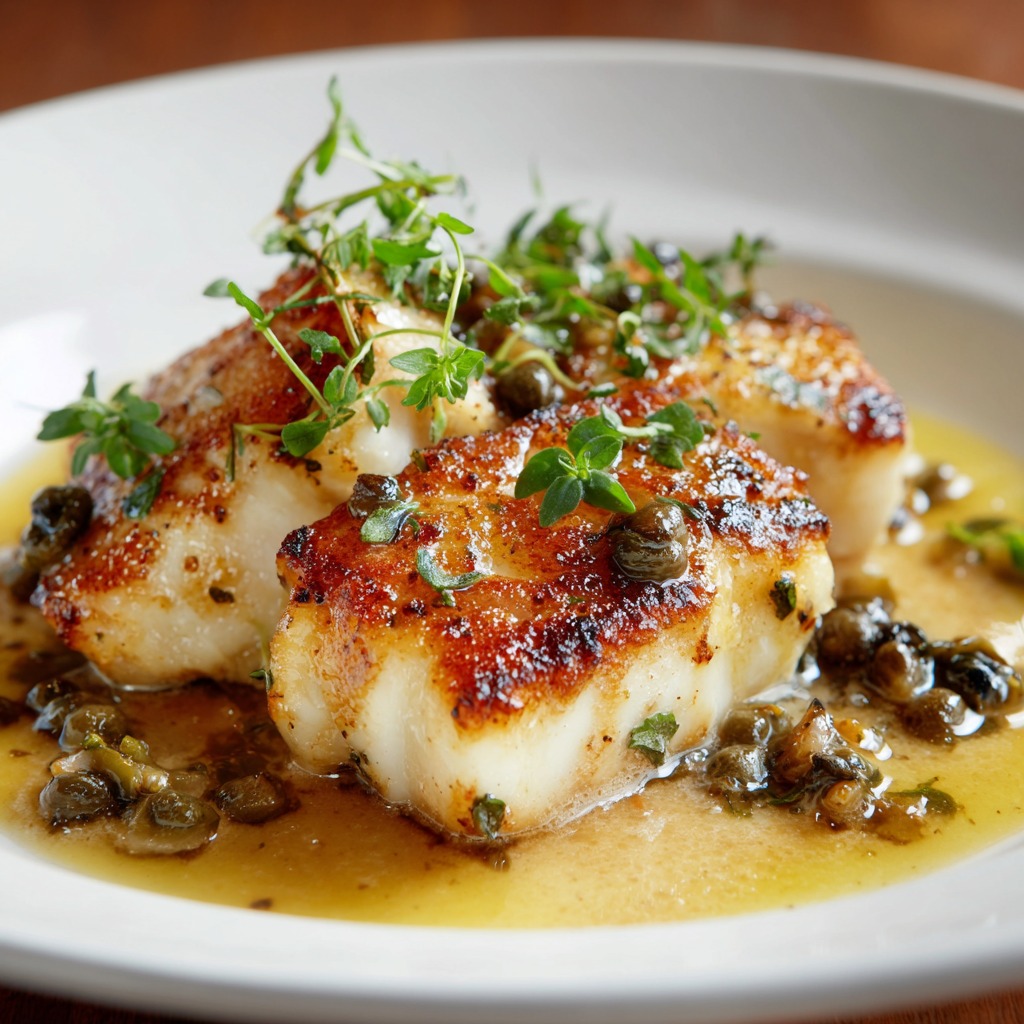
Prepare the Halibut:
- Pat the halibut fillets dry with paper towels. This helps the fish sear properly and prevents it from becoming soggy. Season both sides with salt and pepper.
Sear the Halibut:
- Heat 2 tablespoons of butter in a large skillet over medium-high heat. Once melted, add the halibut fillets.
- Cook the fillets for about 3-4 minutes per side, or until golden brown and cooked through (the internal temperature should reach 145°F). Remove the halibut from the skillet and set aside on a plate.
Make the Sauce:
- In the same skillet, reduce the heat to medium. Add the remaining 2 tablespoons of butter.
- Once the butter is melted, add the minced garlic and sauté for about 30 seconds, until fragrant but not browned.
Add the Lemon and White Wine:
- Add the lemon zest and juice, followed by the white wine. Stir to combine, scraping up any bits from the bottom of the skillet. Let it simmer for 2-3 minutes, allowing the sauce to reduce slightly.
Incorporate Capers and Artichokes:
- Add the capers and chopped artichokes to the sauce. Stir to combine and cook for another 2-3 minutes to warm everything through.
Finish the Sauce:
- Stir in the chopped fresh herbs (parsley or thyme) and adjust the seasoning with salt and pepper to taste.
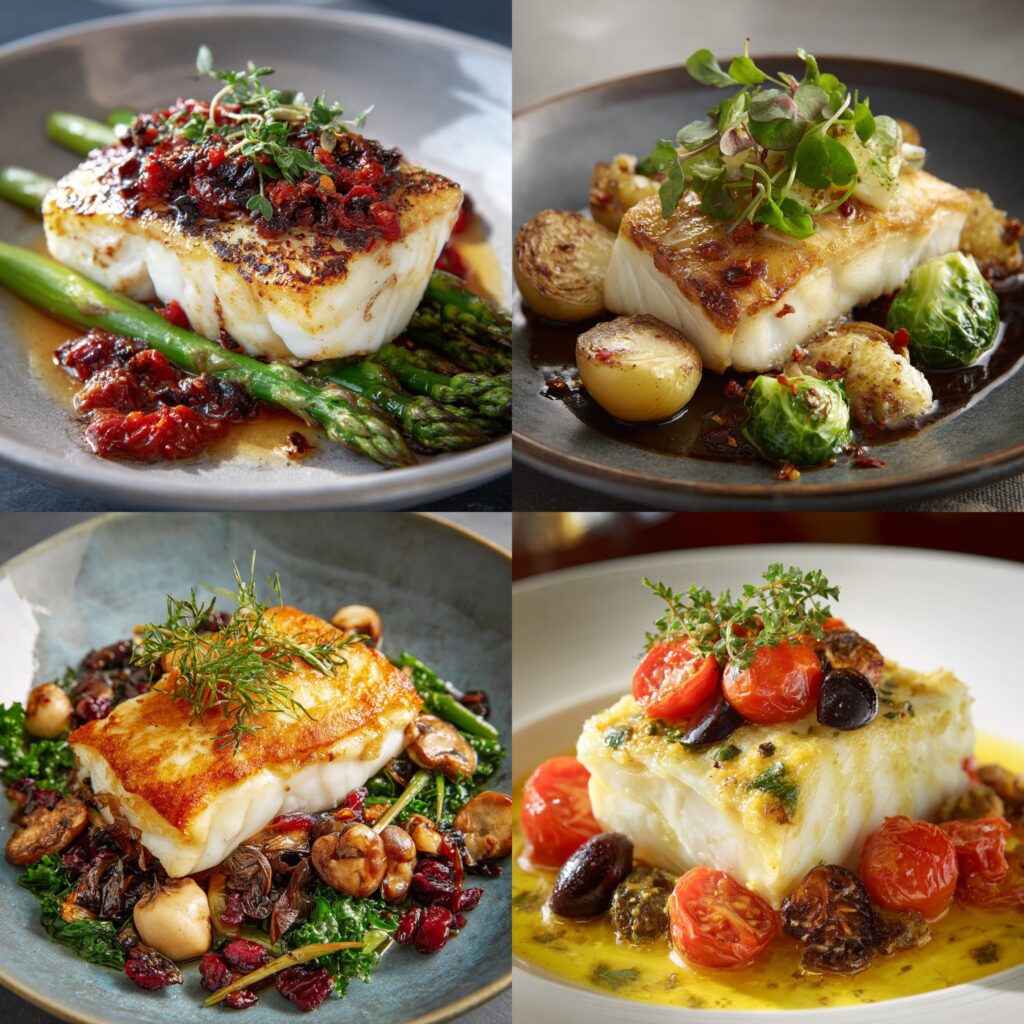
Serve:
- Place the halibut fillets back into the skillet, spooning the sauce over the top. Let the fish cook in the sauce for another minute or two to soak up the flavors.
- Serve the halibut immediately with the sauce spooned over the top. You can garnish with extra herbs and lemon wedges if desired.
Serving Suggestions:
Serve your Halibut Olympia with sides like roasted vegetables, mashed potatoes, or a light salad to balance out the richness of the dish. Enjoy your gourmet meal!
Best Side Dishes for Creamy Halibut Olympia
Here are some of the best side dishes to pair with the Halibut Olympia recipe:
- Roasted Vegetables:
- A medley of roasted vegetables like carrots, asparagus, or Brussels sprouts adds a savory contrast to the rich, buttery fish. The caramelized flavors from roasting complement the dish beautifully.
- Garlic Mashed Potatoes:
- Creamy mashed potatoes with garlic make a comforting side that pairs perfectly with the rich sauce of the halibut. The potatoes soak up the sauce, creating a flavorful bite.
- Lemon Herb Rice:
- A light, fluffy rice dish with fresh lemon zest and chopped herbs is a refreshing and simple side that balances the richness of the halibut. The citrusy notes tie in well with the lemon in the fish sauce.
- Sauteed Spinach:
- A healthy, quick side dish of sautéed spinach with garlic and olive oil adds a burst of color and nutrients. The slightly bitter taste of spinach complements the buttery fish.
- Cauliflower Rice:
- For a low-carb option, cauliflower rice provides a light, neutral base that doesn’t overpower the delicate flavors of the halibut, while still adding texture.
- Crisp Green Salad:
- A fresh, crisp salad with mixed greens, cucumbers, cherry tomatoes, and a light vinaigrette can provide a refreshing contrast to the richness of the fish, adding some crunch and acidity.
- Grilled Asparagus:
- Grilled asparagus with a touch of olive oil, salt, and pepper offers a smoky flavor that pairs perfectly with the creamy, lemony sauce of the halibut.
- Risotto:
- A creamy risotto with Parmesan or lemon-infused risotto makes an indulgent side dish that complements the texture of the fish and the richness of the sauce.
These side dishes not only complement the Halibut Olympia recipe but also add variety and balance to the meal.
Pro Tips for Cooking halibut alyeska recipe
Here are some pro tips for cooking the Halibut Olympia recipe perfectly:
- Choose Fresh Halibut:
- Fresh halibut makes a big difference in flavor and texture. Look for firm, translucent fillets with no fishy odor. If using frozen halibut, make sure it’s properly thawed before cooking.
- Don’t Overcook the Fish:
- Halibut can dry out quickly if overcooked. Aim for an internal temperature of 145°F (63°C). It should be opaque and flake easily with a fork, but still moist and tender.
- Use a Nonstick or Cast Iron Skillet:
- A nonstick or cast iron skillet helps prevent the fish from sticking and allows for an even, golden-brown sear. Ensure the skillet is preheated before adding the fish for the best results.
- Deglaze with White Wine:
- After searing the fish, deglaze the pan with white wine to lift the flavorful bits stuck to the bottom of the skillet. This adds richness and depth to your sauce.
- Balance the Sauce:
- Taste the sauce as it simmers and adjust the seasoning with salt, pepper, or a splash more lemon or wine. A well-balanced sauce is key to complementing the halibut without overpowering it.
- Herb Freshness:
- Always add fresh herbs at the end of cooking to preserve their bright flavor and color. If you use dried herbs, reduce the amount by one-third to avoid overpowering the dish.
- Use a Spoon for Saucing:
- When serving, spoon the sauce over the fish to allow it to absorb the flavors, rather than just pouring it over the top. This ensures an even distribution of the sauce and enhances the fish’s flavor.
- Let the Fish Rest:
- After cooking, let the halibut rest for a minute or two before serving. This helps retain its moisture and ensures the fish is tender and juicy.
Timing Tips Halibut Olympia Recipe
Here are some timing tips for cooking the anthony’s halibut recipe to ensure everything comes together perfectly:
- Preheat the Skillet:
- Make sure your skillet is hot before adding the halibut. Preheating the pan should take about 2-3 minutes over medium-high heat. This will help achieve a nice golden sear on the fish.
- Searing the Halibut:
- Sear the halibut fillets for about 3-4 minutes per side. The exact time will depend on the thickness of the fillets. The fish should have a golden crust and be cooked through, with an internal temperature of 145°F.
- Making the Sauce:
- After removing the halibut from the pan, make the sauce in about 5-7 minutes. Start by sautéing the garlic (30 seconds), then add lemon juice, wine, and allow it to reduce for 2-3 minutes. Add capers, artichokes, and herbs towards the end to warm through, which should take another 2-3 minutes.
- Simmering the Sauce:
- Once the sauce is ready, simmer for 2-3 minutes to allow the flavors to meld and reduce slightly. Keep the heat medium-low to avoid over-reducing the sauce or burning the garlic.
- Resting the Fish:
- Once the fish is cooked, let it rest for about 1-2 minutes before serving. This helps redistribute the juices, ensuring the halibut stays moist and tender.
- Timing the Sides:
- If you’re preparing side dishes like mashed potatoes or roasted vegetables, make sure to start them before cooking the halibut so they’re ready around the same time. Mashed potatoes typically take 15-20 minutes, and roasted vegetables take around 20-25 minutes in the oven.
By following these timing tips, you’ll be able to perfectly sear the halibut, make a flavorful sauce, and serve a well-timed, balanced meal.
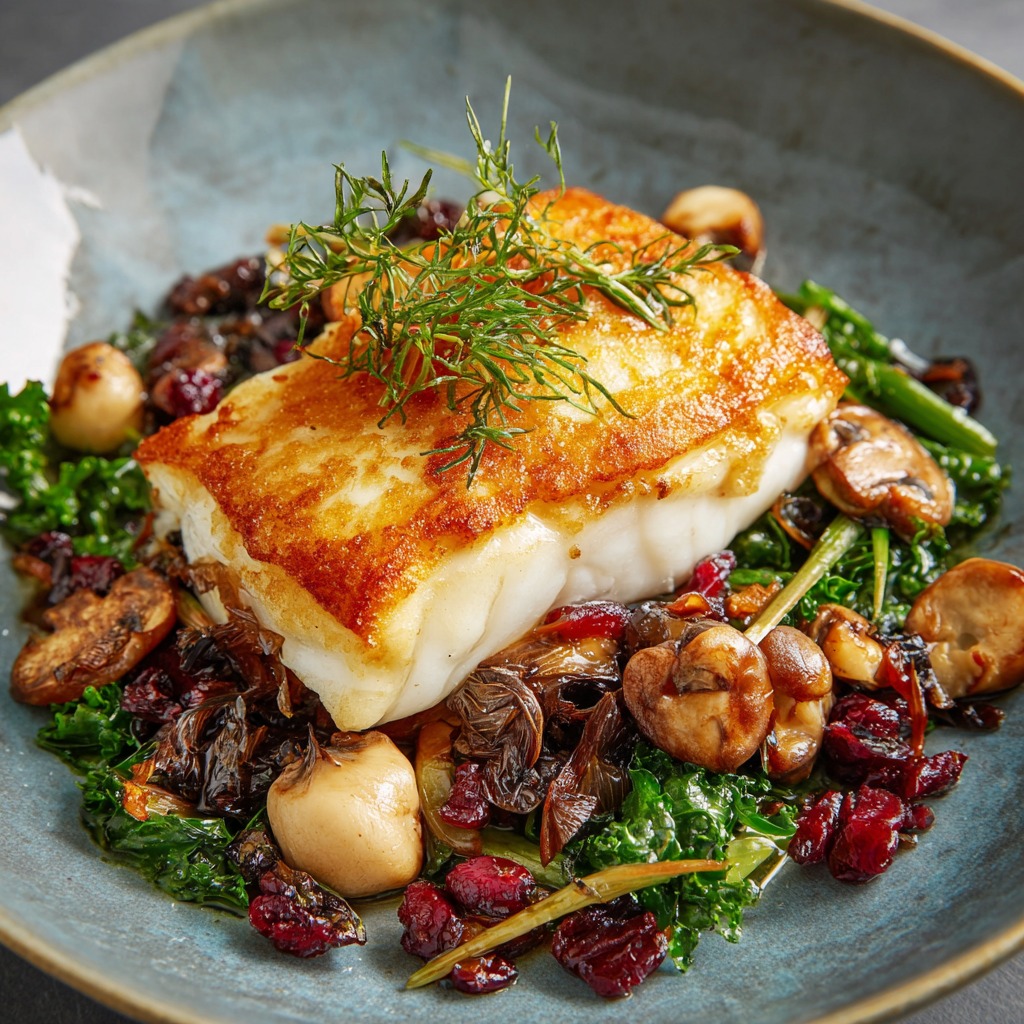
Common Mistakes to Avoid Halibut Olympia Recipe
Here are some common mistakes to avoid when cooking the easy halibut olympia recipe alaska
:
Overcooking the Halibut:
- Halibut can dry out quickly if overcooked. To avoid this, cook the fish until it reaches an internal temperature of 145°F (63°C) and is opaque and flakes easily. It should still be moist and tender.
Not Preheating the Skillet:
- If the skillet isn’t hot enough when you add the fish, it can stick to the pan and fail to sear properly. Always preheat your skillet for 2-3 minutes before adding the halibut to ensure a golden crust.
Skipping the Deglaze:
- After searing the halibut, don’t skip the step of deglazing the pan with white wine. The bits left in the pan (called fond) are full of flavor and will enhance your sauce. Skipping this step can result in a bland sauce.
Adding Herbs Too Early:
- Adding fresh herbs too early in the cooking process can cause them to lose their vibrant flavor. Always add fresh herbs like parsley or thyme at the very end to preserve their aroma and color.
Overloading the Pan:
- Avoid crowding the skillet with too many halibut fillets at once. If your pan is overcrowded, the fish will steam rather than sear. Cook the fillets in batches if necessary to ensure even cooking.
Ignoring Sauce Consistency:
- Make sure to keep an eye on the sauce as it simmers. If it reduces too much, it can become too thick or concentrated. If this happens, simply add a splash of white wine, lemon juice, or water to thin it out.
Not Resting the Fish:
- After cooking, allow the halibut to rest for 1-2 minutes before serving. This helps the juices redistribute, ensuring the fish stays moist and tender. Cutting it too early can result in dry, less flavorful fish.
Neglecting Seasoning Adjustments:
- Taste the sauce as it simmers and adjust the seasoning as needed. Depending on the acidity of your lemon or the saltiness of the capers, you may need to tweak the salt, pepper, or lemon juice to balance the flavors.
Storing and Reheating Halibut Olympia Recipe
Here’s how to properly store and reheat your Halibut Olympia recipe to maintain its freshness and flavor:
Storing the Halibut Olympia:
- Cool the Dish:
- Allow the cooked halibut and sauce to cool down to room temperature within 2 hours of cooking to avoid any bacterial growth.
- Storage Container:
- Store the fish and sauce separately in airtight containers. This will help preserve the texture of the fish and the consistency of the sauce. The fish can be stored in one container, and the sauce in another.
- Refrigeration:
- Place the containers in the refrigerator. The halibut can be safely stored for up to 2-3 days. The sauce should last the same amount of time, though the texture may change slightly after refrigeration.
- Freezing (Optional):
- While it’s best to consume fresh halibut, you can freeze the fish and sauce separately if needed. Wrap the halibut fillets tightly in plastic wrap and place them in a freezer-safe bag. Freeze the sauce in an airtight container. Use within 1-2 months for best quality.
Reheating the Halibut Olympia:
- Reheating the Fish:
- Oven Method (Best for Texture): Preheat the oven to 275°F (135°C). Place the halibut fillets on a baking sheet lined with parchment paper and cover with foil to prevent drying out. Heat for 10-12 minutes, checking occasionally for doneness. The fish should be heated through without becoming overcooked.
- Stovetop Method: Heat a nonstick pan over low heat. Add a little bit of butter or oil, and gently reheat the fish for 2-3 minutes per side. Be careful not to overcook it.
- Reheating the Sauce:
- Stovetop Method: Place the sauce in a saucepan over low to medium heat. Stir frequently and add a splash of water, wine, or lemon juice to restore the sauce’s consistency if it’s become too thick. Heat for 2-4 minutes until hot.
- Microwave Method: If you prefer to microwave the sauce, heat it in a microwave-safe container for 30-45 seconds, stirring halfway through to ensure even heating.
- Reheating Together:
- For a convenient reheating process, you can gently reheat both the fish and the sauce together. Add the fish back to the sauce in a skillet over low heat. Cover and cook for 2-3 minutes until both are heated through, but avoid simmering too long to preserve the fish’s moisture.
By following these tips, you can safely store and reheat your Halibut Olympia while keeping it flavorful and moist.
Tips & Tricks for Perfect
Here are some tips and tricks to ensure your Halibut Olympia turns out perfect every time:
1. Perfectly Sear the Halibut:
- Pat dry the halibut fillets before cooking to ensure a good sear. Moisture on the surface can cause the fish to steam instead of sear.
- Use a nonstick or cast iron skillet for even heat distribution. Always preheat the skillet for about 2-3 minutes before adding the fish.
2. Don’t Overcrowd the Pan:
- If cooking more than one fillet, make sure there’s enough space in the pan for the fish to sear properly. Overcrowding can cause the fish to cook unevenly and not achieve that perfect golden crust.
3. Watch the Cooking Time:
- Halibut cooks quickly. For fillets around 6 oz, aim for about 3-4 minutes per side. Check for doneness by gently pressing the fish with a fork—it should flake easily and be opaque in the center.
4. Enhance the Sauce Flavor:
- Taste the sauce as it simmers. If it’s too tangy, balance it with a little extra butter or cream. If it’s too rich, a splash of white wine or lemon juice can bring back some brightness.
- Add a pinch of sugar if the capers or artichokes are too acidic.
5. Make the Sauce Ahead:
- To save time, you can prepare the sauce ahead of time and reheat it when you’re ready to serve. Just store the sauce in an airtight container in the fridge for up to 2 days.
6. Fresh Herbs Make a Difference:
- Always add fresh herbs like parsley or thyme at the very end of cooking, as they lose their flavor when cooked for too long. For extra flavor, you can add a bit of lemon zest or garlic powder to the sauce.
7. Adjust Sauce Consistency:
- If your sauce becomes too thick, add a splash of wine, broth, or even water to loosen it up. Stir continuously to ensure it remains smooth and silky.
8. Rest the Fish Before Serving:
- Let the fish rest for a minute or two after cooking. This helps it retain moisture and ensures a tender bite.
9. Presentation Tips:
- For a more elegant presentation, garnish with finely chopped herbs, a slice of lemon, or a sprinkle of grated Parmesan cheese.
10. Don’t Skip the Deglaze:
- After searing the fish, deglaze the pan with white wine or broth to incorporate all the delicious bits left behind in the pan. These bits (fond) add depth and flavor to your sauce.
By following these tips and tricks, you’ll elevate your Halibut Olympia to restaurant-quality levels, with perfectly cooked fish and a rich, balanced sauce.
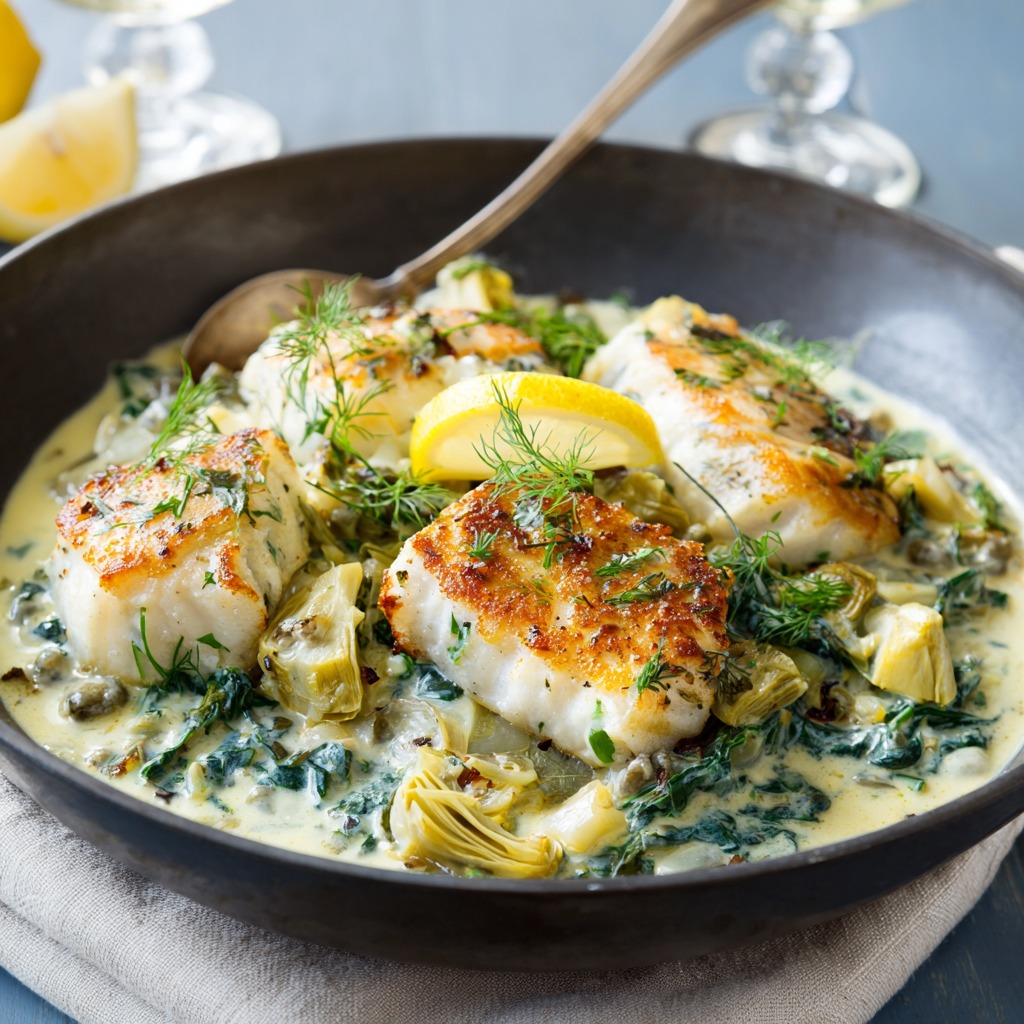
Variations of Halibut Olympia Recipe
Here are some delicious variations of the Halibut Olympia recipe that you can try to put your own spin on this dish:
1. Halibut with Lemon-Caper Butter Sauce:
- Skip the artichokes and add extra lemon juice and capers to the butter sauce. This variation gives the dish a more intense citrus and briny flavor, while still allowing the halibut’s natural taste to shine.
2. Halibut with Spinach and Artichoke:
- Instead of using just artichokes, stir in some sautéed spinach along with the artichokes for added texture and flavor. The spinach provides a fresh, slightly bitter contrast to the rich fish and sauce.
3. Halibut with Mushrooms:
- Add sliced mushrooms to the sauce for an earthy flavor. Mushrooms pair wonderfully with fish and will make the dish feel heartier, especially if you prefer a more robust flavor profile.
4. Halibut with Pesto Sauce:
- Swap out the traditional butter sauce for a basil pesto sauce. This variation adds a fresh, herbaceous note that complements the mild halibut beautifully.
5. Halibut with a Creamy Dill Sauce:
- Substitute the lemon and white wine with cream and add dill for a creamy, tangy sauce. This variation gives the dish a richer, smoother flavor with a bit of herbal freshness.
6. Halibut with Roasted Garlic and Parmesan:
- Add roasted garlic to the sauce for a deeper, sweeter garlic flavor and finish the dish with a generous sprinkle of Parmesan cheese. The nutty, salty cheese will add another layer of flavor.
7. Halibut with Pine Nuts and Sage:
- Toast pine nuts and mix them into the sauce along with crispy sage leaves. This version gives the dish a nutty texture and adds a rustic, savory element that contrasts nicely with the delicate fish.
8. Halibut with White Wine and Tarragon:
- Use tarragon in place of parsley for a more anise-like, slightly licorice flavor. It pairs wonderfully with the white wine in the sauce and creates a slightly French-inspired variation.
Health Benefits of Halibut Olympia Recipe
| Health Benefit | Details |
|---|---|
| High in Protein | Supports muscle growth and repair. |
| Rich in Omega-3s | Promotes heart health and brain function. |
| Low in Calories | Ideal for weight management. |
| Packed with Vitamins | Contains B12, D, and selenium for energy and immune support. |
| Supports Healthy Skin | Healthy fats maintain skin hydration and elasticity. |
| Boosts Immune System | Selenium and omega-3s strengthen immune function. |
Halibut Olympia Recipe From DishBloom!
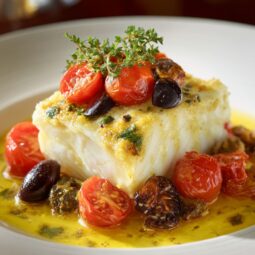
Halibut Olympia
Equipment
- Nonstick or cast iron skillet
- Measuring spoons
- Knife and cutting board
- Spoon or tongs for handling fish
- Citrus juicer/zester
- Small saucepan (optional for reheating the sauce)
Ingredients
- 4 halibut fillets about 6 oz each
- 4 tablespoons butter divided
- 3 cloves garlic minced
- 1 lemon zested and juiced
- 2 tablespoons capers drained
- 1 cup artichoke hearts chopped, fresh or marinated
- 1/4 cup white wine
- 2 tablespoons fresh parsley or thyme chopped
- Salt and pepper to taste
Instructions
- Prepare the Halibut: Pat the halibut fillets dry and season both sides with salt and pepper.
- Sear the Halibut: Heat 2 tablespoons of butter in a skillet over medium-high heat. Add the fillets and cook for 3-4 minutes per side until golden brown and cooked through. Remove from skillet and set aside.
- Make the Sauce: In the same skillet, reduce heat to medium, and melt the remaining 2 tablespoons of butter. Add minced garlic and sauté for 30 seconds.
- Add Lemon and Wine: Add lemon zest, lemon juice, and white wine to the skillet. Stir and allow the sauce to reduce for 2-3 minutes.
- Add Capers and Artichokes: Stir in capers and chopped artichokes, cooking for an additional 2-3 minutes until warm.
- Finish the Sauce:Add fresh herbs, adjust seasoning with salt and pepper, and stir to combine.
- Serve: Place halibut fillets back in the skillet, spoon the sauce over the fish, and serve immediately.

Notes
- You can substitute halibut with other white fish like cod or snapper.
- If you prefer a richer sauce, add a splash of cream to the mixture.
- For added texture, top the fish with a few toasted pine nuts or chopped almonds.
- The dish pairs well with roasted vegetables, mashed potatoes, or a light green salad.

Share Your Twist!
We all have our own unique spin on recipes—why not make Halibut Olympia your own? Here are a few ideas to inspire you:
- Add a Spice Kick: Want some heat? Add a pinch of crushed red pepper flakes to the sauce for a spicy twist.
- Herb Infusion: Swap out the parsley for fresh basil or dill for a new flavor profile. You can even try a combination of fresh herbs for added complexity!
- Vegetable Variations: Experiment with different vegetables like spinach or mushrooms instead of artichokes for a different texture and flavor.
- Crispy Topping: Try sprinkling a few toasted breadcrumbs or crushed almonds over the top for an extra crunch.
- Smoky Flavor: Add a touch of smoked paprika to the sauce for a subtle smoky depth.
We’d love to hear your personal twist on Halibut Olympia! What new ingredients or techniques did you try? Share your version with us and inspire others to experiment in the kitchen.

